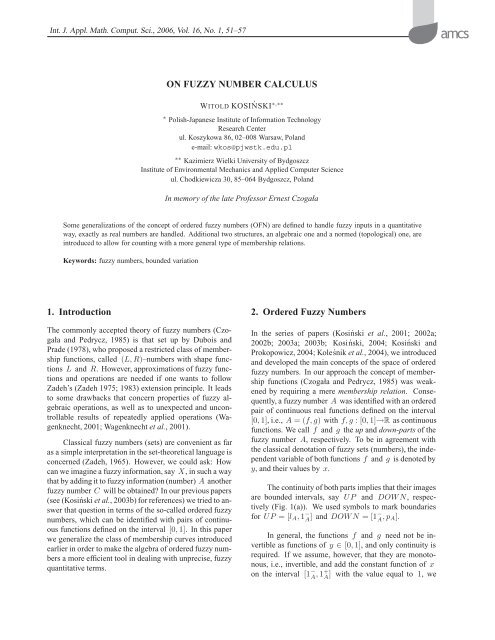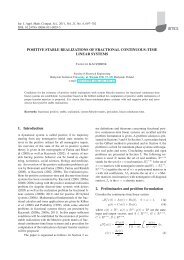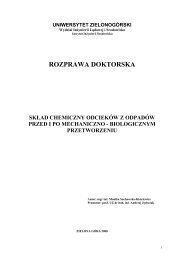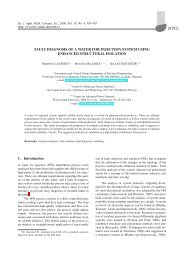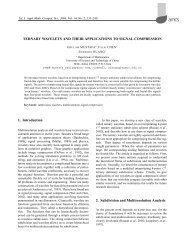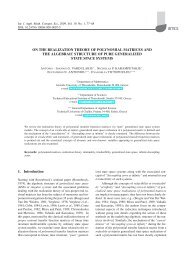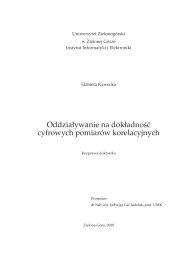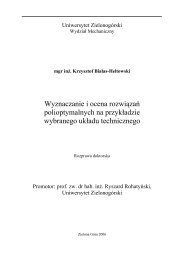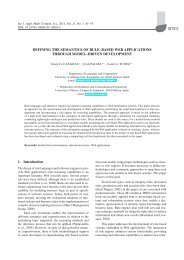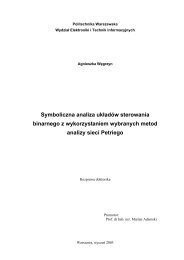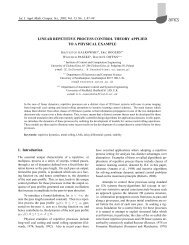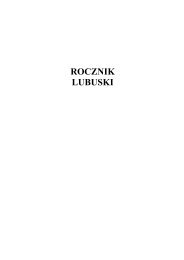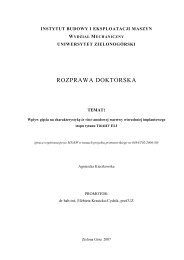ON FUZZY NUMBER CALCULUS 1. Introduction 2. Ordered Fuzzy ...
ON FUZZY NUMBER CALCULUS 1. Introduction 2. Ordered Fuzzy ...
ON FUZZY NUMBER CALCULUS 1. Introduction 2. Ordered Fuzzy ...
You also want an ePaper? Increase the reach of your titles
YUMPU automatically turns print PDFs into web optimized ePapers that Google loves.
Int. J. Appl. Math. Comput. Sci., 2006, Vol. 16, No. 1, 51–57<br />
<strong>ON</strong> <strong>FUZZY</strong> <strong>NUMBER</strong> <strong>CALCULUS</strong><br />
WITOLD KOSIŃSKI ∗,∗∗<br />
∗ Polish-Japanese Institute of Information Technology<br />
Research Center<br />
ul. Koszykowa 86, 02–008 Warsaw, Poland<br />
e-mail: wkos@pjwstk.edu.pl<br />
∗∗ Kazimierz Wielki University of Bydgoszcz<br />
Institute of Environmental Mechanics and Applied Computer Science<br />
ul. Chodkiewicza 30, 85–064 Bydgoszcz, Poland<br />
In memory of the late Professor Ernest Czogała<br />
Some generalizations of the concept of ordered fuzzy numbers (OFN) are defined to handle fuzzy inputs in a quantitative<br />
way, exactly as real numbers are handled. Additional two structures, an algebraic one and a normed (topological) one, are<br />
introduced to allow for counting with a more general type of membership relations.<br />
Keywords: fuzzy numbers, bounded variation<br />
<strong>1.</strong> <strong>Introduction</strong><br />
The commonly accepted theory of fuzzy numbers (Czogała<br />
and Pedrycz, 1985) is that set up by Dubois and<br />
Prade (1978), who proposed a restricted class of membership<br />
functions, called (L, R)–numbers with shape functions<br />
L and R. However, approximations of fuzzy functions<br />
and operations are needed if one wants to follow<br />
Zadeh’s (Zadeh 1975; 1983) extension principle. It leads<br />
to some drawbacks that concern properties of fuzzy algebraic<br />
operations, as well as to unexpected and uncontrollable<br />
results of repeatedly applied operations (Wagenknecht,<br />
2001; Wagenknecht et al., 2001).<br />
Classical fuzzy numbers (sets) are convenient as far<br />
as a simple interpretation in the set-theoretical language is<br />
concerned (Zadeh, 1965). However, we could ask: How<br />
can we imagine a fuzzy information, say X, in such a way<br />
that by adding it to fuzzy information (number) A another<br />
fuzzy number C will be obtained In our previous papers<br />
(see (Kosiński et al., 2003b) for references) we tried to answer<br />
that question in terms of the so-called ordered fuzzy<br />
numbers, which can be identified with pairs of continuous<br />
functions defined on the interval [0, 1]. In this paper<br />
we generalize the class of membership curves introduced<br />
earlier in order to make the algebra of ordered fuzzy numbers<br />
a more efficient tool in dealing with unprecise, fuzzy<br />
quantitative terms.<br />
<strong>2.</strong> <strong>Ordered</strong> <strong>Fuzzy</strong> Numbers<br />
In the series of papers (Kosiński et al., 2001; 2002a;<br />
2002b; 2003a; 2003b; Kosiński, 2004; Kosiński and<br />
Prokopowicz, 2004; Koleśnik et al., 2004), we introduced<br />
and developed the main concepts of the space of ordered<br />
fuzzy numbers. In our approach the concept of membership<br />
functions (Czogała and Pedrycz, 1985) was weakened<br />
by requiring a mere membership relation. Consequently,<br />
a fuzzy number A was identified with an ordered<br />
pair of continuous real functions defined on the interval<br />
[0, 1], i.e., A =(f,g) with f,g :[0, 1]→R as continuous<br />
functions. We call f and g the up and down-parts of the<br />
fuzzy number A, respectively. To be in agreement with<br />
the classical denotation of fuzzy sets (numbers), the independent<br />
variable of both functions f and g is denoted by<br />
y, and their values by x.<br />
The continuity of both parts implies that their images<br />
are bounded intervals, say UP and DOWN, respectively<br />
(Fig. 1(a)). We used symbols to mark boundaries<br />
for UP =[l A , 1 − A ] and DOWN =[1− A ,p A].<br />
In general, the functions f and g need not be invertible<br />
as functions of y ∈ [0, 1], and only continuity is<br />
required. If we assume, however, that they are monotonous,<br />
i.e., invertible, and add the constant function of x<br />
on the interval [1 − A , 1+ A<br />
] with the value equal to 1, we
52<br />
W. Kosiński<br />
Fig. <strong>1.</strong> <strong>Ordered</strong> fuzzy number (a), an ordered fuzzy number presented as a fuzzy number in classical meaning (b),<br />
and a simplified mark denoting the order of inverted functions (c).<br />
might define the membership function<br />
⎧<br />
f ⎪⎨<br />
−1 (x) if x∈ [f(0),f(1)] = [l A , 1 − A ],<br />
μ(x) = g −1 (x) if x∈ [g(1),g(0)] = [1 + A<br />
⎪⎩<br />
,p A], (1)<br />
1 if x∈ [1 − A , 1+ A ],<br />
if<br />
<strong>1.</strong> f is increasing and g is decreasing, and such that<br />
<strong>2.</strong> f ≤ g (pointwise).<br />
In this way, the obtained membership function<br />
μ(x),x ∈ R represents a mathematical object which resembles<br />
a convex fuzzy number in the classical sense<br />
(Drewniak, 2001; Klir, 1997; Wagenknecht, 2001). Notice<br />
that for the representation of the membership function μ<br />
of the convex fuzzy number one can attach two monotonic<br />
functions μ up := f −1 and μ down := g −1 defined on the<br />
intervals [f(0),f(1)] and [g(1),g(0)], respectively.<br />
In fact, in Fig. 1(c) to the ordered pair of two continuous<br />
functions (here just two affine functions) f and<br />
g there corresponds a membership function of a convex<br />
fuzzy number 1 , with an extra arrow, which denotes the<br />
orientation of the closed curve formed of the graph of the<br />
function and the part of the x axis (which is just the part<br />
of the domain of the function on which its values are different<br />
from zero). On the other hand, the arrow underlines<br />
the fact that we are dealing with an ordered pair of functions.<br />
In this way, we appointed an extra feature to this<br />
object (as well as to its counterpart – the convex fuzzy<br />
number), named the orientation.<br />
Notice that if some of the conditions formulated<br />
above are not satisfied, the construction of the classical<br />
1 As usual, the part of the graph representing vanishing values of the<br />
membership function is not presented here.<br />
membership function is not possible. However, in the<br />
x − y plane the graphs of f and g (as functions of y)<br />
can be drawn together with the constant function of x on<br />
the interval [f(1),g(1)], equal to <strong>1.</strong> Consequently, the<br />
resulting graphs of three functions form together a curve<br />
which can be called the membership curve of an ordered<br />
fuzzy number (f,g) .<br />
3. Operations<br />
Now, in the most natural way, the operation of addition between<br />
two pairs of such functions is defined (cf. our main<br />
definition from (Kosiński et al., 2003b)) as the pairwise<br />
addition of their elements, i.e., if (f 1 ,g 1 ) and (f 2 ,g 2 )<br />
are two ordered fuzzy numbers, then (f 1 + f 2 ,g 1 + g 2 )<br />
will be just their sum. It is interesting to notice that as<br />
long as we are dealing with an ordered fuzzy number<br />
represented by pairs of affine functions of the variable<br />
y ∈ [0, 1], its so-called classical counterpart, i.e., a membership<br />
function of the variable x is just a trapezoidaltype<br />
convex fuzzy number. One should notice, however,<br />
that a trapezoidal type membership function corresponds<br />
not to every pair of affine functions of y (cf. the requirement<br />
of the invertibility of f and g and conditions 1<br />
and 2 formulated in Eqn. (1)); some of them are improper<br />
(as was noticed already in (Kosiński et al., 2003b) like in<br />
Fig. <strong>2.</strong><br />
If we want to add two pairs of affine functions (i.e.,<br />
two particular types of ordered fuzzy numbers) defined on<br />
[0, 1], the final result is easy to obtain, since interval calculus<br />
can then be used. Here a mnemotechnic method<br />
of adding (as well as subtracting and multiplying by a<br />
scalar, i.e., by a real, crisp number) of ordered fuzzy numbers<br />
represented by pairs of affine functions can be given.<br />
If for any pair of affine functions (f,g) of y ∈ [0, 1]<br />
we form a quaternion (tetrad) of real numbers according
On fuzzy number calculus<br />
53<br />
Fig. <strong>2.</strong> Sum of two convex OFNs is an improper convex number.<br />
If for A =(f,g) we define its complement Ā =<br />
(−g, −f) (note that Ā ≠(−1) · A), then the sum A + Ā<br />
gives a fuzzy zero 0=(f − g, −(f − g)) in the sense<br />
of the classical fuzzy number calculus. If we attach to<br />
A =(f,g) the corresponding number of the opposite orientation<br />
A ⊥ =(g, f), then we can see that the difference<br />
between them is a fuzzy zero, i.e.,<br />
A − A ⊥ =(f − g, −(f − g)) (4)<br />
Fig. 3. Multiplication.<br />
to the rule [f(0),f(1),g(1),g(0)] (which correspond to<br />
the four numbers [l A , 1 + A , 1− A ,p A]) of Eqn. (1), then this<br />
tread uniquely determines 2 the ordered fuzzy number A.<br />
If (e, h) =:B is another pairs of affine functions, then<br />
the sum A + B =(f + e, g + h) =:C will be uniquely<br />
represented by the tread<br />
[<br />
]<br />
f(0)+e(0),f(1)+e(1),g(1)+h(1),g(0)+h(0) . (2)<br />
In a similar way, if we want to multiply an OFN, say<br />
A, by a scalar λ ∈ R, then the product λA will have its<br />
tread representation in the form<br />
where<br />
λA ←→<br />
A ←→<br />
[<br />
]<br />
λf(0),λf(1),λg(1),λg(0)<br />
[<br />
]<br />
f(0),f(1),g(1),g(0) . (3)<br />
In the assumed definitions (cf. Kosiński et al., 2003a), the<br />
operation of subtraction is compatible with a linear structure<br />
of OFNs, i.e., A − B := A +(−1)B. The representations<br />
(2) and (3) are at our disposal to find the result of<br />
the subtraction A − B in the form of the corresponding<br />
tread.<br />
2 Only one line segment can be drawn through two points in the<br />
plane.<br />
like before. For a better presentation of the advantages of<br />
the new operations on OFN we add extra figures for the<br />
sum, the difference and the product of A by the inverse<br />
of B, i.e., the division A/B.<br />
In Fig. 2 we can follow the operation of addition<br />
using the tread representation of two trapezoidal ordered<br />
fuzzy numbers. In fact, for the number A we have the<br />
tread [1, 2, 3, 5], and for B (which has the opposite orientation<br />
to that of A) the corresponding tread is [6, 4, 4, 3].<br />
Taking the sum of both treads (componentwise), we will<br />
get<br />
[1, 2, 3, 5]+[6, 4, 4, 3] = [7, 6, 7, 8] ←→ A+B = C, (5)<br />
which is the tread representation of the sum C = A + B.<br />
For a better presentation of the advantages of the new<br />
operations on OFN, we add extra figures for the products<br />
of A by B and by the inverse of B, i.e., the division<br />
A/B. Notice that the inverse 1/B of an ordered fuzzy<br />
number B is defined as an ordered fuzzy number such<br />
that the product B · (1/B) gives a crisp one, i.e., an ordered<br />
fuzzy number represented by the pair of constant<br />
functions (1 † , 1 † ), where 1 † (y) =1 for all y ∈ [0, 1].<br />
4. Generalization<br />
However, there are some limitations if we pass from the<br />
concept of ordered fuzzy numbers (OFN) represented by<br />
ordered pairs of continuous functions (even those satisfying<br />
Conditions 1 and 2 above) to the theory of convex<br />
fuzzy numbers represented by their membership functions.<br />
This is because some membership functions already
54<br />
W. Kosiński<br />
Fig. 4. Inverse of B.<br />
Fig. 5. Division A/B.<br />
known in the classical theory of fuzzy numbers (cf. Czogała<br />
and Pedrycz, 1985; Guanrong and Tat, 2001; Łachwa,<br />
2001; Piegat, 1999) cannot be obtained by taking inverses<br />
of continuous functions f and g in the process described<br />
above. We think here about such membership functions<br />
which are piecewise constant (cf. Fig. 7)), i.e., μ is one<br />
of them if its branches μ up and μ down are not strictly<br />
monotonous.<br />
The lack of strict monotonicity of the branches μ up<br />
and μ down as functions of x and, consequently, the existence<br />
of constancy subintervals imply that the inverse<br />
functions to μ up and μ down , regarded as functions of y,<br />
do not exist in the classical sense. To solve this problem<br />
(in terms of the weaker concept of ordered fuzzy numbers,<br />
which is a membership relation) we may assume that for<br />
both functions μ up and μ down there exists a finite (or at<br />
most countable) number of such constancy subintervals,<br />
and then the inverse functions, say f and g, respectively,<br />
exist in a generalized sense, i.e., they are piecewise continuous<br />
and monotonous with a finite (or at most countable)<br />
number of discontinuity points. Those discontinuity<br />
points are of the first order, i.e., at each such point onesided<br />
limits of the functions exist, which may be different.<br />
Then each jump of discontinuity in the y variable<br />
corresponds to a constancy subinterval in the x variable.<br />
In this way we arrived at a class of functions larger<br />
than continuous ones from among which elements of pairs<br />
(f,g) are selected. This is the class of real-valued functions<br />
of bounded (finite) variation (Łojasiewicz, 1973).<br />
Now we are well prepared (cf. Appendix) to introduce a<br />
generalization of the original definition of ordered fuzzy<br />
numbers, cf. (Kosiński et al., 2002a; 2002b; 2003a).<br />
Definition <strong>1.</strong> By an ordered fuzzy number A we mean an<br />
ordered pair (f,g) of functions such that f,g :[0, 1]→R<br />
are of bounded variation.<br />
Operations on new ordered fuzzy numbers are introduced<br />
in much the same way as in (Kosiński et al., 2001;<br />
2002a; 2002b; 2003a; 2003b; Kosiński, 2004; Kosiński<br />
and Prokopowicz, 2004; Koleśnik et al., 2004). Notice,<br />
however, a minor difference in the definition of division.<br />
Definition <strong>2.</strong> Let A = (f A ,g A ),B = (f B ,g B ) and<br />
C = (f C ,g C ) be mathematical objects called ordered<br />
fuzzy numbers. The sum C = A + B, subtraction<br />
C = A − B, product C = A · B, and division C = A/B<br />
are defined by<br />
f C (y) =f A (y) ⋆f B (y), g C (y) =g A (y) ⋆g B (y), (6)<br />
where ‘⋆’ stands for ‘+’, ‘−’, ‘·’, and ‘/’, respectively,<br />
and A/B is defined if the functions |f B | and |g B | are<br />
bounded from below by a positive number.<br />
As was already noticed in the previous section, the<br />
subtraction of B is the same as the addition of the opposite<br />
of B, i.e., the number (−1) · B.
On fuzzy number calculus<br />
55<br />
(i) Visual Studio 6.0 – an environment for programming<br />
in the C++ language;<br />
(ii) Bison-Flex – a generator of the language (a useful<br />
tool to build the syntax analyzer).<br />
Fig. 6. <strong>Ordered</strong> fuzzy number as a pair of<br />
functions of bounded variation.<br />
Fig. 7. Membership function of an ordered fuzzy number.<br />
Additionally, the following, more set-theoretic operations<br />
can be defined:<br />
Definition 3. Let A = (f A ,g A ),B = (f B ,g B ) and<br />
C = (f C ,g C ) be mathematical objects called ordered<br />
fuzzy numbers. The maximum C = A ∨ B and the minimum<br />
C = A ∧ B are defined by<br />
{<br />
f C (y) = func<br />
}<br />
f A (y),f B (y) ,<br />
{<br />
}<br />
g C (y) = func g A (y),g B (y) , (7)<br />
where ‘func’ stands for ‘max’ and ‘min’, respectively.<br />
Many operations can be defined in this way for pairs<br />
of functions. A <strong>Fuzzy</strong> Calculator was already created<br />
as a calculation tool by Roman Koleśnik (Koleśnik et<br />
al., 2004). It facilitates an easy future use of all mathematical<br />
objects described as ordered fuzzy numbers.<br />
This tool (a program called zCalc) was created with<br />
a graphical shell named zWinCalc and is not limited to<br />
piecewise linear parts (quasi-trapezoidal representations)<br />
only. It can run on any form of functions written in a symbolic<br />
way, i.e., by formulas, as well as given in a graphical<br />
way by points on the plane (a coordinate system). To create<br />
the main zCalc program, the following components<br />
were used:<br />
The tool zCalc was written as a component of the operating<br />
system Windows (9x/XP). To this end, a console interface<br />
which allows us to use the main module as a kind of<br />
the interpreter of a specifical simply language was added.<br />
Algebraic operations on OFN offer a unique possibility<br />
to define new types of compositional rules of fuzzy<br />
inference which play a key role in approximate reasoning<br />
when conclusions from a set of fuzzy if–then rules are to<br />
be derived.<br />
Examples of such compositional rules of inference<br />
were given based on the multiplication operator in which<br />
all fuzzy sets are OFNs, in the Ph.D. thesis (Prokopowicz,<br />
2005). Moreover, to determine activation levels of multicondition<br />
rules (or firing the strength of the fuzzy rule),<br />
new methods of aggregation of their premise parts were<br />
also proposed in (Prokopowicz, 2005). These aspects will<br />
be the subject of the next article.<br />
The original case of OFNs with continuous elements<br />
(f,g) allows us to define a set of defuzzification operators<br />
thanks to the Riesz-Kakutami-Banach theorem.<br />
5. Further Extensions<br />
Pointwise multiplication by a scalar (crisp) number, together<br />
with addition, leads to a linear structure R, which<br />
is isomorphic to the linear space of real 2D vector-valued<br />
functions defined on the unit interval I =[0, 1].<br />
Hence R can be identified with BV ([0, 1]) ×<br />
BV ([0, 1]), where BV ([0, 1]) is the space of real-valued<br />
functions of bounded variation defined on the interval<br />
[0, 1] (cf. Appendix). Since the space BV ([0, 1]) is a<br />
Banach space in the norm (12) (cf. Appendix), its Cartesian<br />
product can be equipped with the norm as follows:<br />
‖(f,g)‖ =max(|f(0)| + var(f), |g(0)| + var(g)) . (8)<br />
Finally, R is a Banach algebra with the unity (1 † , 1 † ).<br />
One should add that a Banach structure of an extension of<br />
convex fuzzy numbers was introduced by Goetschel and<br />
Voxman (1986). However, they were only interested in<br />
the linear structure of this extension.<br />
A relation of partial ordering in R can be introduced<br />
by defining a subset of those ordered fuzzy numbers which<br />
are greater than or equal to zero. We say a fuzzy number<br />
A =(f,g) is no less than zero, and write A ≥ 0, iff<br />
f ≥ 0 and g ≥ 0. Hence for two ordered fuzzy numbers<br />
B,C the relation B ≥ C holds if B − C ≥ 0. From
56<br />
this we see that R is a partially ordered ring to which the<br />
theory of such rings can be applied.<br />
Acknowledgments<br />
The research work reported in the paper was partially conducted<br />
in the framework of the project supported by the<br />
Ministry of Education and Science in Poland, no. 4 T11C<br />
038 25. The author thanks Prof. Tadeusz Rzeżuchowski<br />
and Dr. Janusz Wąsowski from the Warsaw University of<br />
Technology for inspiring discussions.<br />
References<br />
Alexiewicz A. (1969): Functional Analysis. — Warsaw: Polish<br />
Scientific Publishers (in Polish).<br />
Chen Guanrong and Pham Trung Tat (2001): <strong>Fuzzy</strong> Sets, <strong>Fuzzy</strong><br />
Logic, and <strong>Fuzzy</strong> Control Systems. — Boca Raton, FL,<br />
CRS Press.<br />
Czogała E. and Pedrycz W. (1985): Elements and Methods of<br />
<strong>Fuzzy</strong> Set Theory. — Warsaw: Polish Scientific Publishers<br />
(in Polish).<br />
Drewniak J. (2001): <strong>Fuzzy</strong> numbers. In: <strong>Fuzzy</strong> Sets and their<br />
Applications (J. Chojcan, J. Łęski, Eds.). — Gliwice: Silesian<br />
University of Technology Press, pp. 103–129.<br />
Dubois D. and Prade H. (1978): Operations on fuzzy numbers.<br />
— Int. J. Syst. Sci., Vol. 9, No. 6, pp. 613–626.<br />
Goetschel R. Jr. and Voxman W. (1986): Elementary fuzzy calculus.<br />
— <strong>Fuzzy</strong> Sets Syst., Vol. 18, No. 1, pp. 31–43.<br />
Klir G.J. (1997): <strong>Fuzzy</strong> arithmetic with requisite constraints. —<br />
<strong>Fuzzy</strong> Sets Syst., Vol. 91, No. 2, pp. 165–175.<br />
Kosiński W., Piechór K., Prokopowicz K. and Tyburek K.<br />
(2001): On algorithmic approach to opertions on fuzzy<br />
numbers, In: Methods of Artificial Intelligence in Mechanics<br />
and Mechanical Engineering (T. Burczyński,<br />
W. Cholewa, Eds.). — Gliwice: PACM, pp. 95–98 (in Polish).<br />
Kosiński W., P. Prokopowicz P. and Ślęzak D. (2002a): <strong>Fuzzy</strong><br />
numbers with algebraic operations: algorithmic approach,<br />
In: Intelligent Information Systems 2002 (M. Klopotek,<br />
S.T. Wierzchoń, M. Michalewicz, Eds.). Proc.IIS’2002,<br />
Sopot, Poland — Heidelberg: Physica Verlag, pp. 311–<br />
320.<br />
Kosiński W., Prokopowicz P. and Ślęzak D. (2002b): Drawback<br />
of fuzzy arthmetics — New intutions and propositions, In:<br />
Proc. Methods of Aritificial Intelligence (T. Burczyński,<br />
W. Cholewa, W. Moczulski, Eds.). — Gliwice: PACM,<br />
pp. 231–237.<br />
Kosiński W., Prokopowicz P. and Ślęzak D. (2003a): On algebraic<br />
operations on fuzzy numbers, In: Intelligent Information<br />
Processing and Web Mining, Proc. Int. Symp.<br />
IIS: IIPWM’03, Zakopane, Poland, 2003 (M. Klopotek,<br />
S.T. Wierzchoń, K. Trojanowski, Eds.). — Heidelberg:<br />
Physica Verlag, pp. 353–36<strong>2.</strong><br />
W. Kosiński<br />
Kosiński W., Prokopowicz P. and Ślęzak D. (2003b): <strong>Ordered</strong><br />
fuzzy numbers. — Bull. Polish Acad. Sci., Ser. Sci. Math.,<br />
Vol. 51, No. 3, pp. 327–338.<br />
Kosiński W. (2004): On defuzzification of ordered fuzzy numbers,<br />
In: Proc. ICAISC 2004, 7th Int. Conference, Zakopane,<br />
Poland, June 2004 (L. Rutkowski, Jörg Siekmann,<br />
R. Tadeusiewicz, Lofti A. Zadeh, Eds.), LNAI. — Berlin:<br />
Springer, Vol. 3070, pp. 326–33<strong>1.</strong><br />
Kosiński W. and Prokopowicz P. (2004): Algebra of fuzzy<br />
numbers. — Matematyka Stosowana. Matematyka dla<br />
Społeczeństwa, Vol. 5, No. 46, pp. 37–63, (in Polish).<br />
Koleśnik R., Prokopowicz P. and Kosiński W. (2004): <strong>Fuzzy</strong><br />
Calculator – useful tool for programming with fuzzy algebra,<br />
In: Artficial Intelligence and Soft Computing –<br />
ICAISC 2004, 7th Int. Conference, Zakopane, Poland<br />
(L. Rutkowski, Jörg Siekmann, R. Tadeusiewicz, Lofti A.<br />
Zadeh, Eds.), Lecture Notes on Artificial Intelligence. —<br />
Berlin: Springer, Vol. 3070, pp. 320–325.<br />
Łachwa A. (2001): <strong>Fuzzy</strong> World of Sets, Numbers, Relations,<br />
Fazts, Rules and Decisions. — Warsaw: EXIT, (in Polish).<br />
Łojasiewicz S. (1973): <strong>Introduction</strong> to the theory of real functions.<br />
— Warsaw: Polish Scientific Publishers, (in Polish).<br />
Martos B. (1983): Nonlinear Programming – Theory and Methods.<br />
— Warsaw: Polish Scientific Publishers, (in Polish).<br />
Piegat A. (1999): <strong>Fuzzy</strong> Modeling and Control. — Warsaw: PLJ,<br />
(in Polish).<br />
Prokopowicz P. (2005): Algorithmic operations on fuzzy numbers<br />
and their applications. — Ph. D. thesis, Institute of<br />
Fundamental Technological Research, Polish Acad. Sci.,<br />
(in Polish).<br />
Wagenknecht M. (2001): On the approximate treatment of fuzzy<br />
arithmetics by inclusion, linear regression and information<br />
content estimation, In: <strong>Fuzzy</strong> Sets and Their Applications<br />
(J. Chojcan, J. Łęski, Eds.). — Gliwice: Silesian University<br />
of Technology Press, pp. 291–310.<br />
Wagenknecht M., Hampel R., Schneider V. (2001): Computational<br />
aspects of fuzzy arithmetic based on Archimedean<br />
t-norms. — <strong>Fuzzy</strong> Sets Syst., Vol. 123/1, pp. 49–6<strong>2.</strong><br />
Zadeh L.A. (1965): <strong>Fuzzy</strong> sets. — Inf. Contr., Vol. 8, No. 3,<br />
pp. 338–353.<br />
Zadeh L.A. (1975): The concept of a linguistic variable and its<br />
application to approximate reasoning, Part I. — Inf. Sci.,<br />
Vol. 8, No. 3, pp. 199–249.<br />
Zadeh L.A. (1983): The role of fuzzy logic in the management of<br />
uncertainty in expert systems. — <strong>Fuzzy</strong> Sets Syst., Vol. 11,<br />
No. 3, pp. 199–227.<br />
Appendix<br />
Here we give the most important facts concerning functions<br />
of bounded variations.<br />
Each function h of bounded variation on [0, 1] possesses<br />
at most a countable number of discontinuity points<br />
of the first order and, moreover, each function can be
On fuzzy number calculus<br />
represented as a sum of two functions h(s) =h c (s) +<br />
h j (s), s ∈ [0, 1], where h c is a continuous function of<br />
bounded variation while h j (s) is a function of jumps of<br />
h, called the jump function. In other words, if {s k : k =<br />
1, 2,...} is the sequence (finite or infinite: however, with<br />
different terms) of all discontinuity points of the function<br />
h, then the jump function of h is h j (s) = ∑ k u k, where<br />
for each k the value<br />
and<br />
u k (s) = 0 for ss k , (9)<br />
where h(s k − 0),h(s k +0) are one-sided limits of h<br />
at s k .<br />
It is worthwhile to add that each function of bounded<br />
variation is a difference of two monotonous (exactly increasing)<br />
functions. Hence the function h c in the above<br />
representation is a difference of two increasing continuous<br />
functions.<br />
One needs to stress that not all ordered fuzzy numbers<br />
in the sense of our first definition (Kosiński et al.,<br />
2003a) fulfil the present definition, since they are continuous<br />
functions which do not have bounded variation. For<br />
example, the function h(s) =s cos(π/2s) for s ∈ (0, 1]<br />
and h(0) = 0 is continuous in the whole interval [0, 1]<br />
while its variation, i.e., the upper limit of the sum<br />
n−1<br />
∑<br />
v(h) = |h(s k+1 ) − h(s k )| (10)<br />
k=0<br />
for an arbitrary partition 0=s 0


